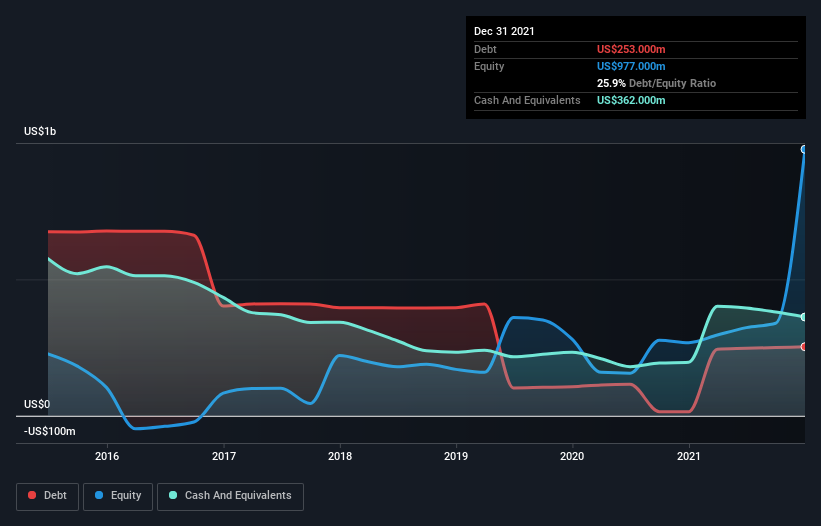Is Eastman Kodak (NYSE:KODK) Using Too Much Debt?
The external fund manager backed by Berkshire Hathaway's Charlie Munger, Li Lu, makes no bones about it when he says 'The biggest investment risk is not the volatility of prices, but whether you will suffer a permanent loss of capital.' So it seems the smart money knows that debt - which is usually involved in bankruptcies - is a very important factor, when you assess how risky a company is. We note that Eastman Kodak Company (NYSE:KODK) does have debt on its balance sheet. But should shareholders be worried about its use of debt?
Why Does Debt Bring Risk?
Debt assists a business until the business has trouble paying it off, either with new capital or with free cash flow. Ultimately, if the company can't fulfill its legal obligations to repay debt, shareholders could walk away with nothing. However, a more usual (but still expensive) situation is where a company must dilute shareholders at a cheap share price simply to get debt under control. Of course, the upside of debt is that it often represents cheap capital, especially when it replaces dilution in a company with the ability to reinvest at high rates of return. When we examine debt levels, we first consider both cash and debt levels, together.
Check out our latest analysis for Eastman Kodak
What Is Eastman Kodak's Net Debt?
The image below, which you can click on for greater detail, shows that at December 2021 Eastman Kodak had debt of US$253.0m, up from US$15.0m in one year. But it also has US$362.0m in cash to offset that, meaning it has US$109.0m net cash.
How Healthy Is Eastman Kodak's Balance Sheet?
According to the last reported balance sheet, Eastman Kodak had liabilities of US$309.0m due within 12 months, and liabilities of US$885.0m due beyond 12 months. On the other hand, it had cash of US$362.0m and US$178.0m worth of receivables due within a year. So it has liabilities totalling US$654.0m more than its cash and near-term receivables, combined.
This deficit casts a shadow over the US$435.6m company, like a colossus towering over mere mortals. So we'd watch its balance sheet closely, without a doubt. At the end of the day, Eastman Kodak would probably need a major re-capitalization if its creditors were to demand repayment. Eastman Kodak boasts net cash, so it's fair to say it does not have a heavy debt load, even if it does have very significant liabilities, in total.
Importantly, Eastman Kodak grew its EBIT by 59% over the last twelve months, and that growth will make it easier to handle its debt. When analysing debt levels, the balance sheet is the obvious place to start. But it is Eastman Kodak's earnings that will influence how the balance sheet holds up in the future. So when considering debt, it's definitely worth looking at the earnings trend. Click here for an interactive snapshot.
But our final consideration is also important, because a company cannot pay debt with paper profits; it needs cold hard cash. Eastman Kodak may have net cash on the balance sheet, but it is still interesting to look at how well the business converts its earnings before interest and tax (EBIT) to free cash flow, because that will influence both its need for, and its capacity to manage debt. Over the last three years, Eastman Kodak saw substantial negative free cash flow, in total. While that may be a result of expenditure for growth, it does make the debt far more risky.
Summing up
While Eastman Kodak does have more liabilities than liquid assets, it also has net cash of US$109.0m. And it impressed us with its EBIT growth of 59% over the last year. Despite its cash we think that Eastman Kodak seems to struggle to convert EBIT to free cash flow, so we are wary of the stock. There's no doubt that we learn most about debt from the balance sheet. But ultimately, every company can contain risks that exist outside of the balance sheet. To that end, you should be aware of the 1 warning sign we've spotted with Eastman Kodak .
When all is said and done, sometimes its easier to focus on companies that don't even need debt. Readers can access a list of growth stocks with zero net debt 100% free, right now.
Have feedback on this article? Concerned about the content? Get in touch with us directly. Alternatively, email editorial-team (at) simplywallst.com.
This article by Simply Wall St is general in nature. We provide commentary based on historical data and analyst forecasts only using an unbiased methodology and our articles are not intended to be financial advice. It does not constitute a recommendation to buy or sell any stock, and does not take account of your objectives, or your financial situation. We aim to bring you long-term focused analysis driven by fundamental data. Note that our analysis may not factor in the latest price-sensitive company announcements or qualitative material. Simply Wall St has no position in any stocks mentioned.

 Yahoo Finance
Yahoo Finance 
